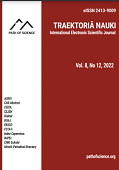Serological Qualitative Diagnoses of Helicobacter pylori in Patients Accessing Care at the Bingham University Teaching Hospital Jos, Nigeria
Serological Qualitative Diagnoses of Helicobacter pylori in Patients Accessing Care at the Bingham University Teaching Hospital Jos, Nigeria
Author(s): Mamzhi Crown Seljul Ramyil, Timothy Olugbenga Ogundeko, Anko Anko, Miriam Silas, Oluwagbenga Adeola, Catherine Nadabo, John Bimba, George Chima, James Bitrus, Cornelius Bello, Paul Bass AmosSubject(s): Health and medicine and law, Demography and human biology
Published by: Altezoro, s. r. o. & Dialog
Keywords: peptic ulcer; H. pylori; seropositivity; gastric cancer; test-and-treat;
Summary/Abstract: The widespread Helicobacter pylori infection is a substantial global health problem affecting approximately 50% of the worldwide population, with 50% infection rates in developed countries and 80% in developing countries, mainly concentrating in resource-limited settings. The mode of transmission is through the faecal-oral route, contamination of food and water, where inadequate sanitation practices, low socioeconomic status and overcrowdedness seem to relate to the high prevalence of H. pylori infections. This study sought to serologically determine the prevalence of H. pylori and the disease-associated burden in patients accessing care in a Tertiary Hospital. This hospital-based cross-sectional study was conducted at the Bingham University Teaching Hospital, North-Central Nigeria, for four months (September to December 2022). There, 551 blood specimens were collected from the patients into plain tubes and spun to obtain serum for the serological qualitative analysis. Out of the 551 screened specimens for H. pylori, 79% (n=437) were 58.4% reactive female and 41.6% male. Ages 15-49 had 62%, 50-70 yrs had 26.5%, and less than 14 yrs had 11.4% respectively. Furthermore, 64.3% of female patients presented with burning pains, nausea/vomiting, and trouble breathing. In comparison, 35.5% of the male counterparts presented symptoms of dyspepsia, and 32.1% had either taken one of the Nonsteroidal-inflammatory drugs. 86.7% of the suspected patients were hand washed after using the toilet, 83.3% had a loss of appetite, 55.4% reported alcohol intake and 35.9% smoked instead. 47.7% ate from mama-put, 30.1% from street-vended foods and 22.2% from classified restaurants, while 94.7% got their drinking water from sachet, bottled, borehole or tap, and well water, respectively. Serum antibody detection of H. pylori infection was higher in female than male patients accessing care at the Bingham University Teaching Hospital, Jos. This revealed that gender could be considered a potential risk factor. Thus, early risk identification factors, such as other transmission routes, are urgently needed in defining clinical and epidemiological characteristics to facilitate appropriate supportive care and prompt treatment.
Journal: Traektoriâ Nauki
- Issue Year: 9/2023
- Issue No: 6
- Page Range: 3001-3007
- Page Count: 7
- Language: English

